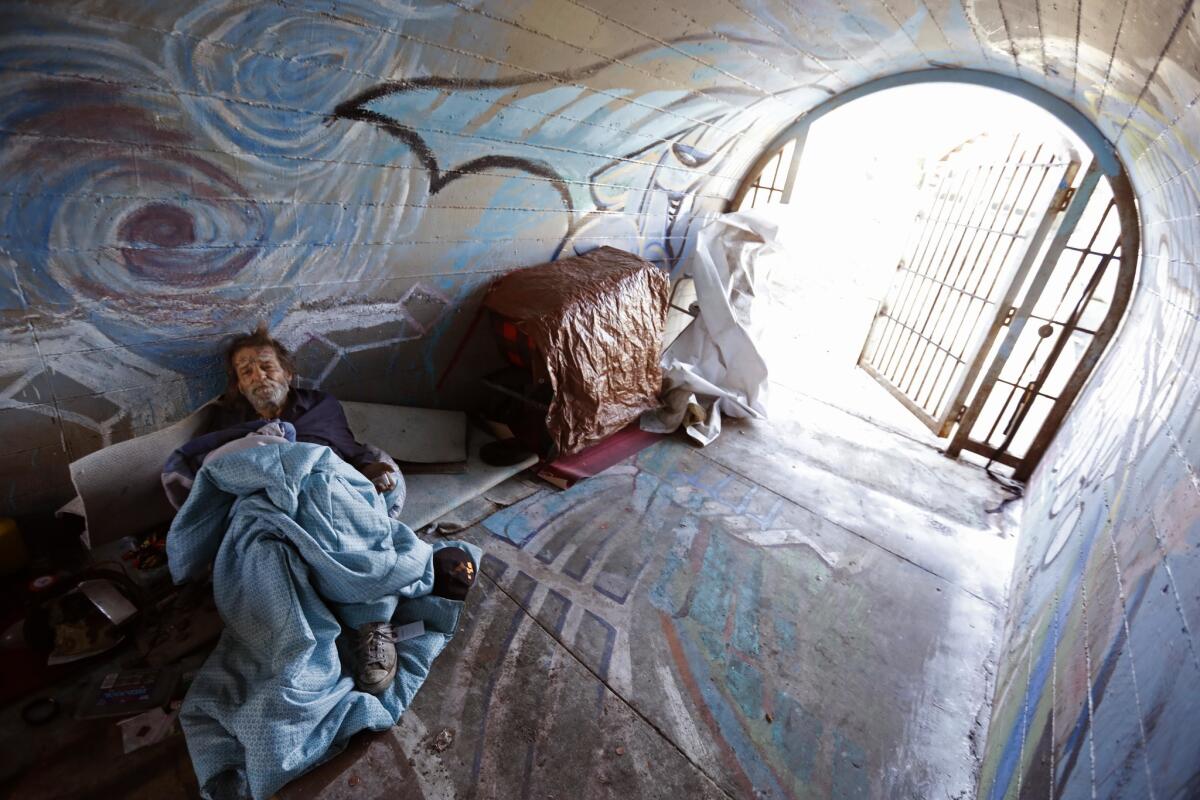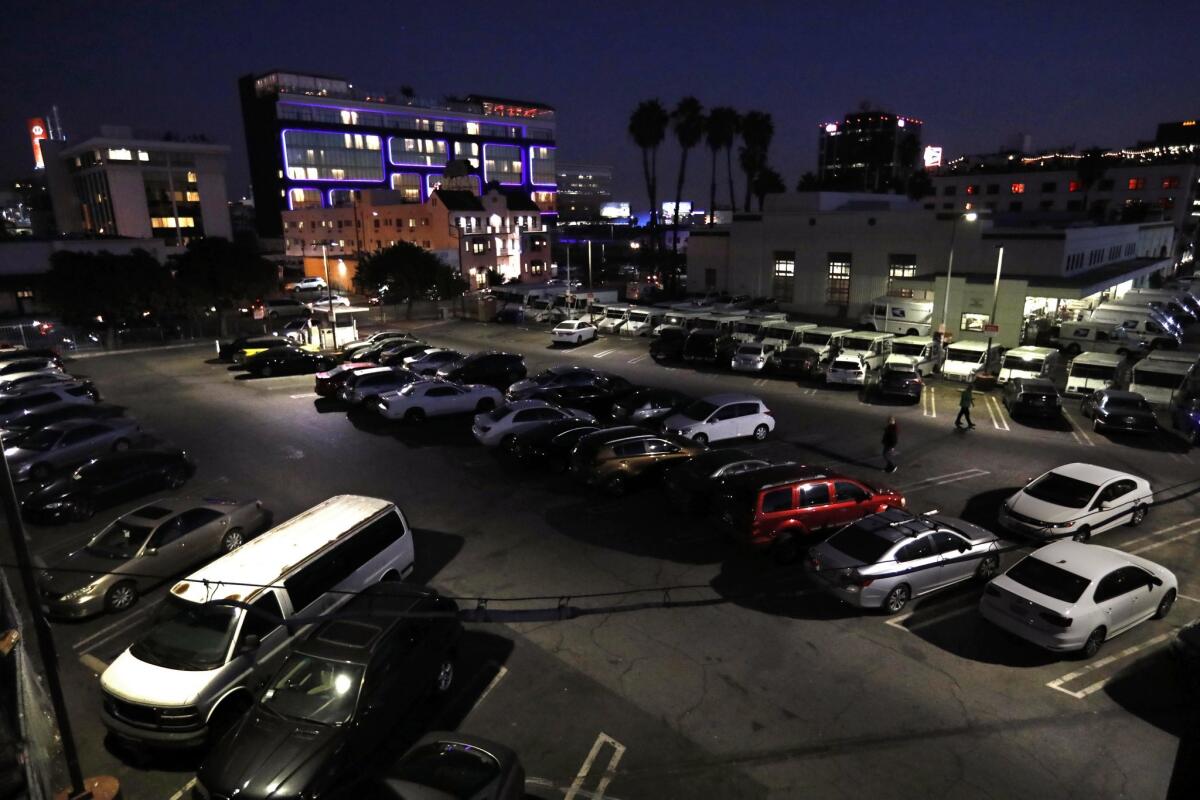A plan to house L.A.’s homeless residents could transform parking lots across the city

In the decades following World War II, when the suburbs were young and the car was king, Los Angeles went on a land-buying spree.
The city bought parcels in every size and shape, demolished any buildings on them and opened parking lots to serve emerging commercial districts.
By the 1970s the buying had mostly stopped, and today these 119 public lots blend into the urban quilt all but indistinguishable from their free-market competitors.
But now the city is cultivating plans that could transform much of that land again, this time from asphalt to multistory apartment buildings to house chronically homeless people.
Plans are already underway to develop housing on large public lots in Venice and Hollywood, while officials review the rest to determine which could support housing.
Advocates of the conversion see it as more than a solution to homelessness.
“These opportunities ought to be evaluated in terms of the next vision of what the city ought to be,” said Eric Moss, the architect on a project that would squeeze 140 units onto the Venice parking lot, along with a parking structure to preserve all the spaces there now. “Those lots belong to a completely different history and a completely different time.”
But how many of them ultimately prove viable will depend on many unknowns, among them the reaction of council offices and neighborhood groups and the ingenuity of architects in making the most of parcels that in many cases are small, oddly shaped and represent a prized resource.
“I think we’re going backwards,” Lincoln Heights real estate broker Steven Kasten said about a proposal to build on lots there. “Merchants are not going to have parking. People are going to move out. It’s going to hurt business.”
The idea of converting public parking to housing has been around for decades in L.A. but has gained little traction. In the 1980s, Mayor Tom Bradley proposed leasing rights to developers to build multifamily housing, but there was no follow-up.
Northeast-area Councilman Gil Cedillo revived the idea in 2008 with a plan to build 80 units on three city lots near the Gold Line in Highland Park.
That plan fell into limbo after a neighborhood group, Friends of Highland Park, sued, alleging the environmental review approved by the city was inadequate. A trial court’s ruling for the city was overturned on appeal. The city chose not to appeal further, and the project remains stalled.
The new parking lot review grew out of an urgency to implement Proposition HHH, the $1.2-billion bond measure approved by the voters to help fund the construction of 1,000 permanent supportive housing units each year.
With taxpayer funds now committed, a new obstacle emerged. The scarcity of suitable land in the city’s highly competitive real estate market could add years to the start-up time for new projects.
Mayor Eric Garcetti and the City Council have promised the city would speed up construction by providing land from its portfolio of surplus property.
After sifting through more than 500 prospects, the City Administrative Office has narrowed the field to 129 sites that are potentially large enough and in suitable zones. All but 10 are public parking lots.
The city’s Housing and Community Investment Department is also planning to offer affordable housing developers 24 city-owned lots, most acquired from the Community Redevelopment Agency when it was dissolved by the state in 2012.
Combined, the properties could support thousands of new units. Some would go to low-income renters, whether they are homeless or not. But even if only half the units were set aside for homeless people, that would make up a substantial boost to the 10-year building goal.
But the hope that using city properties would dramatically speed the pace of construction is being tested by the realities of city procedures.
Yolanda Chavez, an assistant city administrative officer, said the office is reviewing lots a few at a time and will confer with the Department of Transportation to determine their suitability and the number of spaces that need to be preserved.
Then a motion from the City Council office is required to proceed with a planning report. After that the lot can be offered for bidding.
Chavez said she hopes to offer several properties for proposals in February and then a few more twice a year.
Because the process incurs costs, such as appraisal fees, Chavez said she requires a show of support from a City Council member in the form of a motion before she will begin it.
Though there are city parking lots in almost every council district, only a handful of motions have been introduced so far.
A Times survey of dozens of lots showed challenges unique to each.
The smallest, with only seven spaces on West Washington Boulevard in Mid-City, is among a few that may simply be too small for multistory buildings. The largest is unlikely to be replaced by housing. It is a structure with more than 3,000 spaces built into the Dolby Theatre complex in Hollywood, and generates $12 million a year in revenue.
Most are on side streets a block from major suburban boulevards and serve one- or two-story commercial buildings.
Architects will have to design three- to five-story buildings that blend with both the businesses and with adjoining residential neighborhoods.
About two-thirds of the lots are metered and bring revenue to the city.
The amount of parking to be replaced would have to be decided case by case.
Because many of the lots are in clusters, there are opportunities for creative planning. Replacement parking could be built on one lot, for example, with housing on other ones nearby.
In almost every case, the scale of the project would change the character of a neighborhood, potentially bringing new life to aging business districts, but almost certainly stirring opposition in some. The strategy is getting its first test in Venice.
Parking Lot 731, spanning the Grand Canal, provides 188 spaces in a parking-tight district where bohemian businesses, struggling artists and owners of multimillion-dollar homes mix only two blocks from the beach. It pulls in more than $1 million a year for the city.
Two nonprofits, Venice Community Housing and Hollywood Community Housing Corp., have been selected to develop the lot, with plans for 140 housing units in two buildings on either side of the historic canal.
The project is required to preserve all the public parking, with an additional 143 spaces for the tenants and retail, said Venice Community Housing executive director Becky Dennison.
Preliminary designs by Eric Owen Moss Architects show the parking in two multistory structures encircled by the living spaces and retail — a configuration made possible by the size of the property, at 121,000 square feet one of the city’s largest parking lots.
The plan has yet to be formally presented to the community, but preliminary plans released last year stirred opposition from some community groups.
Moss said capturing the spirit of Venice is his challenge as he is “working carefully within a height limit, working carefully within a unit count, reconstitution of the canal, public sense of obligation to retail and art walks. We’re fitting all of those intelligently onto the site.”
Safran & Associates, a for-profit developer, has been selected to develop affordable housing on a lot on Wilcox Avenue in Hollywood, across the street from the high-end Dream Hollywood hotel.

Tyler Monroe, Safran’s vice president for development, said plans for the 45,000-square-foot lot are not set but will preserve the existing 149 spaces.
Because they are so large, the Venice and Hollywood lots are among the least challenging for designers.
Across the city, seven smallish lots scattered around North Broadway in Lincoln Heights may set the tone for how the program will unfold in other aging commercial centers, including Echo Park, Van Nuys, Reseda, Canoga Park and Sawtelle.
The lots are not financial assets for the city. Three offer free parking, and the others generate only hundreds of dollars a year per space, compared with thousands for more-productive lots.
Collectively they provide a large building space, but it is cut into inconveniently small pieces. The smallest is only 10,000 square feet.
Cedillo, the area’s councilman, has proposed to offer five of the seven lots for housing. But community reaction could be critical.
At a January meeting of the Lincoln Heights Neighborhood Council, a field deputy for Cedillo faced more than 100 residents who were upset that two developers — WORKS, a northeast L.A. nonprofit, and the for-profit GTM Holdings — were given an exclusive negotiating agreement to build on the lots without public input.
The deputy, Jose Rodriguez, told the residents they would be able to work with the developer to design the plan.
Channa Grace, the president and chief executive of WORKS, said she expects the project to include senior housing and other affordable housing and some replacement parking, in addition to permanent supportive housing for homeless people.
“We’re looking to have a robust outreach and get input from the community,” Grace said.”Take what we find and go out into the community. Talk to folks, see what they’re thinking.”
Some who attended the neighborhood council meeting expected those talks to be tough.
“There is no warmth for this project right now from this community,” said Lincoln Heights resident and political blogger Scott Johnson.
Twitter: @LATDoug
More to Read
Sign up for Essential California
The most important California stories and recommendations in your inbox every morning.
You may occasionally receive promotional content from the Los Angeles Times.











